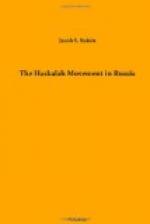That the Russian Jews of the day were not altogether unenlightened, that they not only practiced the Law devoutly, but also studied it diligently, and cultivated the learning of the time as well, we may safely infer from researches recently made. Cyril, or Constantine, “the philosopher,” the apostle to the Slavonians, acquired a knowledge of Hebrew while at Kherson, and was probably aided by Jews in his translation of the Bible into Slavonic. Manuscripts of Russo-Jewish commentaries to the Scriptures, written as early as 1094 and 1124, are still preserved in the Vatican and Bodleian libraries, and copyists were doing fairly good work at Azov in 1274.
Jewish scholars frequented celebrated seats of learning in foreign lands. Before the end of the twelfth century traces of them are to be found in France, Italy, and Spain. That in the eleventh century Judah Halevi of Toledo and Nathan of Rome should have been familiar with Russian words cannot but be attributed to their contact with Russian Jews. However, in the case of these two scholars, it may possibly be ascribed to their great erudition or extensive travels. But the many Slavonic expressions occurring in the commentaries of Rashi (1040-1105), and employed by Joseph Caro (ab. 1140), Benjamin of Tudela (ab. 1160), and Isaac of Vienna (ab. 1250), lend color to Harkavy’s contention, that Russian was once the vernacular of the Russian Jews, and they also argue in favor of our contention, that these natives of the “land of Canaan”—as the country of the Slavs was then called in Hebrew—came into personal touch with the “lights and leaders” of other Jewish communities. Indeed, Rabbi Moses of Kiev is mentioned as one of the pupils of Jacob Tam, the Tosafist of France (d. 1170), and Asheri,




